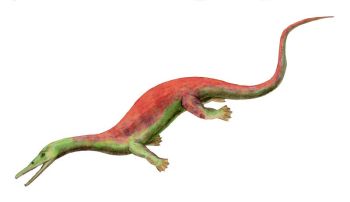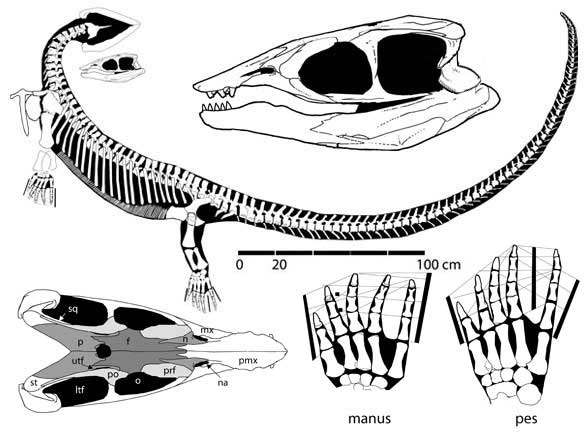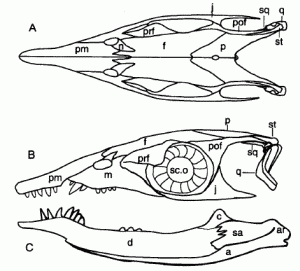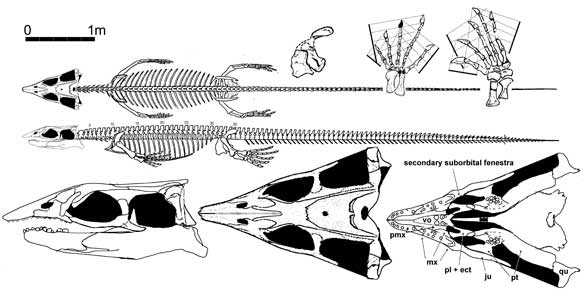
| Palaeos |  |
Diapsida |
| Vertebrates | Thalattosauria |
| Page Back | Unit Home | Unit Dendrogram | Unit References | Taxon Index | Page Next |
| Unit Back | Vertebrates Home | Vertebrate Dendrograms | Vertebrate References | Glossary | Unit Next |
|
Abbreviated Dendrogram
AMNIOTA |--SYNAPSIDA `--SAUROPSIDA |--ANAPSIDA `==EUREPTILIA | `--DIAPSIDA |==Araeoscelida `--Neodiapsida |=="Younginiformes" `--+--Claudiosaurus |--Weigeltisauridae `--+--+--Thalattosauria/Thalattosauriformes | | |--Askeptosauroidea | | | |--Endennasaurus | | | `--Askeptosauridae | | `--Thalattosauroidea | | |--+--Nectosaurus | | | `--Xinpusaurus | | `--Thalattosauridae | | `--+--Thalattosaurus | | `--Claraziidae | `--ICHTHYOSAURIA |?--Omphalosaurus |?--Saurosphargidae |?--Hupehsuchia `--Sauria |?--CHORISTODERA |--LEPIDOSAUROMORPHA `--ARCHOSAUROMORPHA |
Contents
Overview |
 Endennasaurus acutirostris, an Askeptosaurian thalattosaur from the Late Triassic of Tethys Italy, Illustration by Nobu Tamura (Wikipedia). Thalattosaurs were only one of a number of diverse groups of marine diapsid reptiles that evolved in parallel during the Triassic period. |
Thalattosaurs (meaning "ocean lizards") are marine diaspids of uncertain affinities. They resembled large (upto two to four meters or more in length) aquatic lizards, with long, flexible bodies and short but stocky limbs (see Zachary Miller When Pigs Fly Returns). They were among the more successful of the Triassic marine reptiles, and evolved along a number of distinct lines, although all appeared to be near-shore types, like the contemporary early ichthyosaurs, pachypleurosaurs, nothosaurs, helveticosaurs, proto-turtles, and trematosaur amphibians and other animals they shared the marine environment with.
Thalattosaurs are divided into two main groups: Askeptosaurs and Thalattosaurs. While quite diverse and widespread (being known from Europe, North America, and China) they are not common as fossils; recently (2011) a rare almost complete skeleton was discovered in Alaska (link, Google search). The following cladogram is from Mikko's Phylogeny Archive, 2004, modified according to Wu et al 2009
Thalattosauriformes |--Askeptosauroidea | |--Endennasaurus | `--Askeptosauridae | |--Askeptosaurus | `--+--Anshunsaurus (Wikipedia - detailed page) | `--Miodentosaurus `--Thalattosauroidea |--+--Nectosaurus | `--Xinpusaurus `--Thalattosauridae |--Agkistrognathus `--+--Paralonectes `--+--Thalattosaurus `--Claraziidae |--Clarazia `--Hescheleria |
 Miodentosaurus brevis, a thalattosaurian from the Late Triassic of China, Illustration by Nobu Tamura (Wikipedia). Although this reconstruction shows a tail fin (see also ) it is equally possible that the tail was long and tapering like that of a modern marine iguana. |
As with most of the other lineages of specialised Triassic marine reptiles, larger relationships are unclear. Thalattosaurs have been variously included under "Eosuchia" (Romer 1966), "rhynchocephalia" (Sphenodontia) (Kuhn 1969), with sauropterygians (Reippel 1998, Nosotti & Rieppel, 2003, Li et al 2011), with ichthyosaurs as stem Sauria (Bickelmann, Müller & Reisz, 2009) and with ichthyosaurs as stem euryapsida within basal archosauromorpha (Merck, 1997, Borsuk-Bialynicka & Evans 2009). Ass often the case, different toplogies are proposed by different workers in the field. Since two different sources have linked them with ichthyosaurs, we have tentatively followed suit here, although the sauropterygian option may be just as viable. Alternatively, they could be related to neither of these major groups, and the similarities simply due to convergence. MAK101003, 111125
 Askeptosaurus italicus, Middle Triassic of Tethys Europe, Illustration by Nobu Tamura (Wikipedia) |
Thalattosauriformes (= Thalattosauria)
Range: Middle to Late Triassic.
Phylogeny: Younginiformes ::: (?Ichthyopterygia + * : Askeptosauroidea + Thalattosauroidea
Characters: elongate rostrum (snout) and premaxillae, nostrils set back, premaxillae contact frontal bones, upper temporal fenestra slit like or closed, lower temporal fenstra open below, limbs paddle like (Benton, 1985 p.151; Rieppel, 1987)
Comments: The terminology varies, with the larger thalattosaur-askeptosaurid group being called either Thalattosauria (Cheng et al 2007) or Thalattosauriformes (Müller et al., 2005), whilst the name Thalattosauroidea has been used for the more exclusive thalattosaur group (Rieppel et al., 2000).
Note on phylogeny: As with most of these early specialised groups, the actual evolutionary relationships of the thalattosaurs is unclear. They have been associated with lepidosaurs, ichthyosaurs, and archosauromorphs. It is even possible that the ichthyosaurs are related to archosauromorph (although the fish-lizards are such a specialised group it is hard to know for sure where they belong), which would make it possible for thalattosaurs to be related to both. For now we have tentatively (hence the question amrks in the menu-cladogram) placed them near the base of the ichthyosaur lineage, without making any further judgment on the overall topology of the diapsid tree. Hopefully further research will give a better understanding of the evolutionary relationships and origins of these little known but intriging Triassic reptiles. MAK101011 110923
Link: Wikipedia, UCMP - Basal Diapsids (only a paragraph),
Range: Middle to Late Triassic.
Phylogeny: Thalattosauriformes : Thalattosauroidea + * : Endennasaurus + Askeptosauridae
Comments: generally unspecialised forms, without the paddle-like feet. MAK101003
Askeptosauridae : Askeptosaurus, Anshunsaurus, Miodentosaurus
Range: Middle (Anisian/Ladinian) to Late (Carnian) Triassic of Europe and China.
Phylogeny: Askeptosauroidea : Endennasaurus + * : Askeptosaurus + Miodentosaurus
 Reconstruction of skull and skeleton of Askeptosaurus italicus. The original animal was about 2 meters long. Drawing copyright © David Peters - Reptile Evolution - original url, reproduced with permission. |
Askeptosaurus:
Range: Middle Triassic (Anisian/Ladinian) of central Europe.
Phylogeny: Askeptosauridae : Miodentosaurus +*
Characters: elongate, parallel-sided rostrum that terminates in a blunt tip (Rieppel et al 2005), thecodont dentition, rhomboidal interclavical (also in Tanystrophid prolcertiformes) (Rieppel, 1987 p.128), no teeth on vomer or pterygoid, pleurothecodont teeth, neck longer and limbs less paddle-like than than Thalattosaurus (Benton, 1985 p.152); elongated eel-like body, very long tail about half the animal's total length, size 2 to 2.5 metres, large eyes with protective bony ring, suited to dim light and deep water (Wikipedia - Askeptosaurus) MAK101003
Comments:
Askeptosaurus was originally classified with Thalattosaurus as the Thalattosauridae, currently these are considered representatives of two distiinct lineages
Link: David Peters - Reptile Evolution, Wikipedia
 Reconstruction of skull and skeleton of Miodentosaurus brevis from the late Triassic of China. From the scale bar (see also photo) the original animal was about 5 meters long, which makes it among the biggest of the Thalattosaurs. Note, the skull at the lower left is too narrow, compare with photo (previous link). Drawing copyright © David Peters - Reptile Evolution - original url, reproduced with permission. |
Miodentosaurus : Miodentosaurus brevis Cheng et al. 2007
Range: Late Triassic (Carnian) of China.
Phylogeny: Askeptosauridae : Askeptosaurus +*
Horizon: Upper Triassic Wayao Member of the Falang Formation, Guanling area, Guizhou Province
Comments: Differs from Askeptosaurus in having a much shorter rostrum and fewer teeth.
Links: Miodentosaurus brevis (thalattosaurian) - Chinese academy of sciences, photo, note how short the skull is; David Peters - Reptile Evolution; Wikipedia
Range: Late Triassic of Tethys Europe.
Phylogeny: Askeptosauroidea : Askeptosauridae + *
Comments: a specialised, toothless form, similar to Askeptosaurus, but with a longer toothless jaws.
Link: Wikipedia, David Peters - Reptile Evolution
Range: Middle to Late Triassic.
Phylogeny: Thalattosauriformes : Askeptosauridae + * : (Nectosaurus + Xinpusaurus) + Thalattosauridae
Characters: Clarazia and Thalattosaurus have a relatively short rostrum distinct from the elongate Askeptosaurid condition, with convergent lateral margins and that terminates in a pointed tip, supratemporal contacts frontal bone, heavy postorbital bar, diastema separates the premaxillary from the maxillary teeth, deep lower jaw (Rieppel, 1987; Rieppel et al 2005)
Comments: One of the two major clades of thalattosaurs, the other being the Askeptosauroidea. Specialised forms tend towards a durophageous (feeding on molluscs or other hard-shelled animals) condition, convergent with placodonts and omphalosaurs. (MAK101003) The Thalattosauroidea are easily distingusihed by the distinctive downturned snouts. In Clarazia and Thalattosaurus, the snouts taper to a narrow tip, with the premaxillae (the front jaw bones) at the tip are downturned. Xinpusaurus also has downturned premaxillae, but the end of the maxillae are sharply upturned, forming a notch in the skull. In Hescheleria, Nectosaurus, and Paralonectes, the premaxillae are abruptly downturned at the end of the snout, forming nearly a right angle with the rest of the jaw. In these forms, the end of the snout is a toothy hook separated from the rest of the jaw by a space (a diastema) (from Wikipedia)
Nectosaurus Nectosaurus halius
Range: Carnian of California.
Phylogeny: Thalattosauroidea : Thalattosauridae + (Xinpusaurus + *)
Characters: Highly derived rostral structure: maxilla is short with an anteriorly truncated (vertical) margin, a narrow but high ascending process, and a dorsally curving medial flange that is in natural articulation with the ventrally deflected vomer. nearly vertically placed premaxilla. Rieppel et al 2005
Link: Wikipedia MAK101003
 Reconstructed skull of the small Thalattosaur Xinpusaurus c.f. suni from the Carnian of China, length 14 cm. This genus is very close to Nectosaurus, a contemporary form from California, showing the global distribution of these animals. Diagram from Liu & Rieppel 2001 p.83 |
Xinpusaurus Xinpusaurus suni
Range: Carnian of China.
Phylogeny: Thalattosauroidea : Thalattosauridae + (Nectosaurus + *)
Characters: Small size, short snout with weak ventral bend
Comments: Originally described as a Cymbospondyline ichthyosaur. David Peters - Reptile Evolution gives a different-looking skull, with a swordfish/euhrinosaurus-like extended upper mandible. Controversially interprets Xinpusaurus as a basal Thalattosauriforme, related to the mesosaur Stereosternum, Hupehsuchus, and the basal ichthyopterygian Utatsusaurus
Reference: Liu & Rieppel 2001 MAK101003
Thalattosauridae : Agkistrognathus, Clarazia, Hescheleria, Paralonectes, Thalattosaurus
Range: Middle to Late Triassic.
Phylogeny: Thalattosauroidea : (Nectosaurus + Xinpusaurus) + * : Thalattosaurus + Claraziidae
Characters: see under Thalattosauroidea
 Reconstruction of skull and limbs of Thalattosaurus alexandrae , from the Carnian of California. The original animal is estimated at about two meters long. Drawing copyright © David Peters - Reptile Evolution - original url, reproduced with permission. |
Thalattosaurus Thalattosaurus alexandrae Merriam 1904
Range: Early/middle (Olenekian/Anisian) to Late (Carnian) Triassic.
 Thalattosaurus alexandrae , reconstructed by John C. Merriam, incorrectly showing a straight rostrum. This image is reproduced a number of times, e.g. Zittel and Eastman's Textbook of paleontology - Wikipedia, pubic domain. Reference: Merriam 1905 |
Phylogeny: Thalattosauridae : Claraziidae + *
Characters: elongate snout, limbs paddle like, upto 2.5 meters (Benton, 1985 p.152), thecodont dentition (also in Tanystrophid prolcertiformes) (Rieppel, 1987 p.128)
Comments: The post-crania is poorly known, but the humerus and femur appear short and robust (Peters). Merriam's reconstruction of the skull (left) incorrectly shows a simple, straight snout and jaws, Peters shows a down-curved rostrum like that of Clarazia and Xinpusaurus, or even for that matter Chasmatosaurus or Dilophosaurus. Thalattosaurus alexandrae (UCMP-9084) was named by Merriam in 1904 in honor of Annie Alexander, an amateur paleontologist and patron to the University of California Museum of Paleontology (Hilton 2003 p.80)
Links: David Peters - Reptile Evolution, Wikipedia
 Reconstruction of skull and skeleton of Clarazia schinzi. The original animal was about a meter long. Drawing copyright © David Peters - Reptile Evolution - original url, reproduced with permission. |
Claraziidae : Clarazia, Hescheleria
Range: Middle Triassic of Switzerland.
Phylogeny: Thalattosauridae : Thalattosaurus + *
Characters: about a meter long, acrodont dentition, general lepidosaur skeleton, heavy jaws, duraphagous (shellfish-eating) dentition, overhanging premaxilla (convergent with Archosauriformes) , 30-32 presacral (neck and back) vertebrae, long deep tail about 60% of overall length, reduced limbs, large paddle-like hands and feet, cruciform interclavical (convergent with lepidosaurs) (Benton, 1985 p.151; Rieppel, 1987)
Comments: . Considered Diapsida incertae sedis by Benton, 1985, shown to be Thalattosaurs by Rieppel, 1987 who placed them alongside Thalattosauridae, later revisions by Rieppel and others make the Claraziidae a daughter clade of Thalattosauridae. So perhaps should be renamed Claraziinae. MAK101003
Links: David Peters - Reptile Evolution
| Page Back | Unit Home | Page Top | Page Next |
page last modified MAK110923
